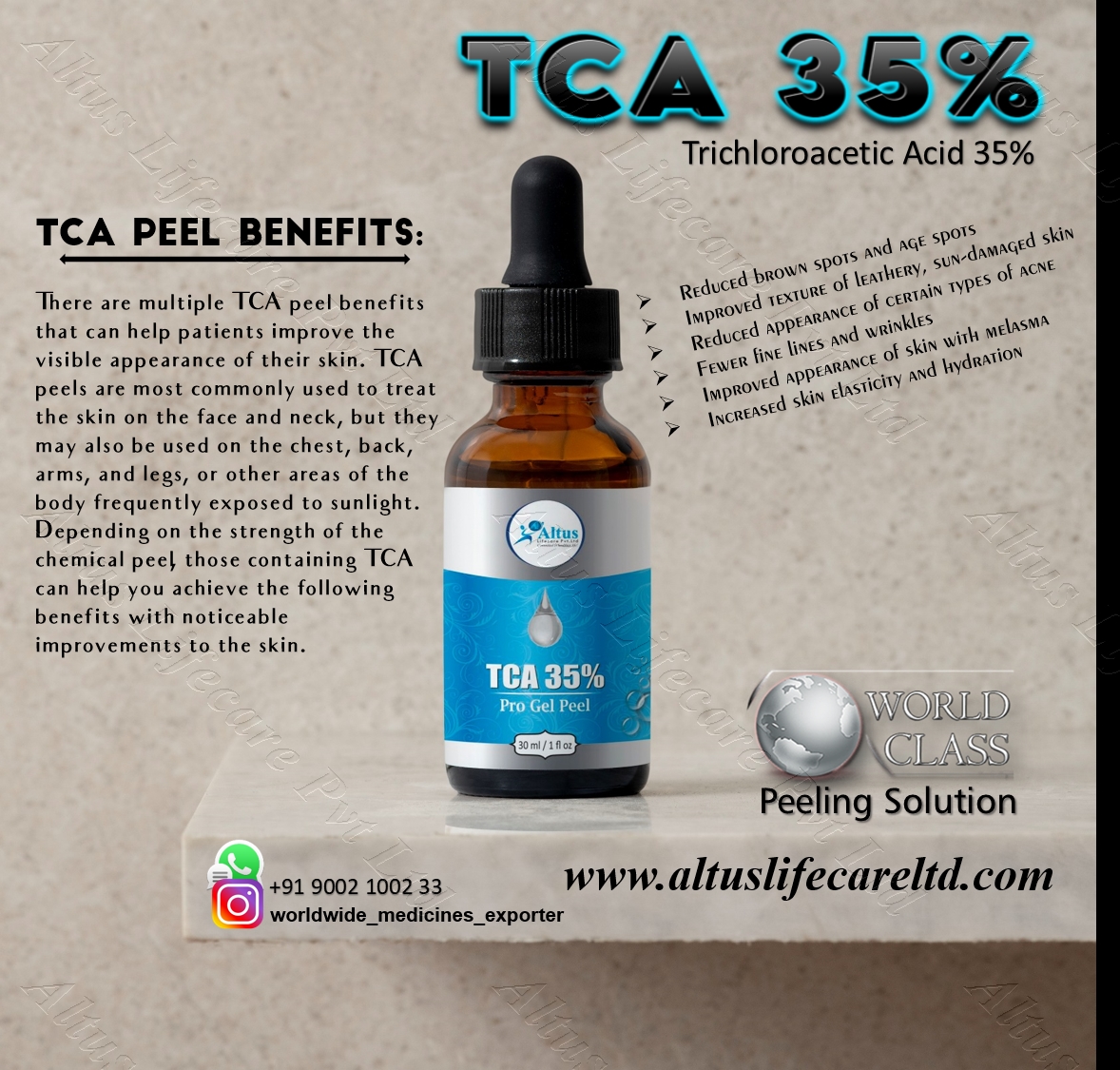
TCA 35% peel is one of the most popular cosmetic procedures performed to restore the appearance of skin and one of the most effective chemical peel at home types. Over the years, scars, acne, sun damage and other factors contribute to form lines and wrinkles in the face. This causes the skin to lose its smooth, youthful appearance. Frequently, performed on the face, neck, and hands. Most types of chemical peel reduce the appearance of facial scars, wrinkles and other skin imperfections. While improving the skin density and firmness leaving skin with a glowing complexion. Basically, TCA peel is an alternative to best skin bleaching cream and lightening products.
WHAT IS A TCA 35% PEEL?
A TCA peel is a noninvasive skin treatment used to treat skin discolorations, scarring, and wrinkles. These peels get their name from trichloroacetic acid (TCA), which is used to clear away dead skin cells to reveal the newer and smoother skin layers below.
TCA peels are part of the group of skin treatments called chemical peels, which are used to exfoliate your skin by using different strengths and combinations of nontoxic acid ingredients.
WHY DOES IT IMPROVE MY SKIN?
A chemical peel is a technique used to improve and smooth the texture of the skin. Facial skin is mostly treated, and scarring can be improved. Chemical peels are intended to remove the outermost layers of the skin. To accomplish this task, the chosen peel solution induces a controlled injury to the skin. Resulting wound healing processes begin to regenerate new tissues. The dead skin eventually peels off. The regenerated skin is usually smoother and less wrinkled than the old skin. Some types of chemical peels can be purchased and administered without a medical license; however people are advised to seek professional help from a licensed Esthetician, dermatologist or plastic surgeon on a specific type of chemical peel before a procedure is performed.
WHO IS A GOOD CANDIDATE FOR TCA PEELS?
Chemical peels can be superficial, medium, or deep strength. TCA peels are considered medium strength, meaning they should only be applied by a certified skin care professional. The ideal candidate for a TCA peel:
- is not breastfeeding or pregnant
- does not have a skin condition such as psoriasis, eczema, or rosacea
- does not have a job that requires them to be outside
- has no history of keloids or poor wound healing
- will be counseled by the doctor beforehand about realistic expectations of the results
- People who have taken the acne medication isotretinoin (Zenatane, Amnesteem, Claravis) should avoid chemical peels for a period of time after completing treatment.
HOW MUCH DOES A TCA PEEL COST?
The cost of a TCA peel is determined by the size of the application area as well as the expected results. In 2018 a chemical peel application cost an average of $693, according to The American Society for Aesthetic Plastic Surgery. Keep in mind that the cost of a TCA peel won’t always be limited to the treatment itself. After a TCA peel, it’s recommended you use additional moisturizing products to protect your face while it heals and rehydrate your skin. These skin care products can get expensive, and the quality of the products you purchase can impact the overall result of your chemical peel as well as how long the results last. If you work in an office setting or spend most of your time indoors, you probably won’t need to take time off from work after a TCA peel. Immediately after the peel is applied, your skin will appear extremely red and irritated. Like other chemical peels, TCA peels are considered an elective procedure. That means that they are not covered by health insurance.

HOW DOES A TCA PEEL WORK?
A TCA peel dissolves cells in the top layer of your skin (epidermis). As the skin that’s been affected by TCA application peels off, new cell growth is encouraged underneath.
Once that top layer of skin has peeled off, a layer of brand-new skin cells becomes visible. Often, the new layer of skin is smoother and less affected by “imperfections” such as wrinkles and acne scarring.
PROCEDURE FOR A TCA PEEL
The TCA peel treatment itself will probably take around 30 minutes.
Most people feel a burning sensation for the first few minutes of the procedure, followed by a stinging pain as the acid exfoliates and clears away the top layers of your skin.
The procedure is done in a single session. It may be recommended that you prepare your skin with certain products prior to a TCA peel to achieve better results.
If you are looking to achieve a certain result, multiple sessions may be required. It’s advised that you wait several months between chemical peels to allow your skin to fully heal.
You may be sedated during the TCA peel, according to what you and your dermatologist decide.
Targeted areas for TCA peels
TCA peels are typically applied to your face. They can also be used to improve skin’s smoothness and tone on other areas of your body, such as:
- back
- chest area
- neck
- shoulders
- upper arms
ARE THERE ANY RISKS OR SIDE EFFECTS?
There are some risks and side effects for the procedure. Common side effects include:
- redness that lasts for several days or even weeks
- herpes flare-up if you have the herpes simplex virus
- changes in skin color
RARELY, A TCA PEEL CAN CAUSE:
- a bacterial or fungal infection
- organ damage due to chemical exposure
People with darker complexions may be at a higher risk for hyperpigmentation after a chemical peel. Hyperpigmentation causes the layer of skin exposed by the chemical peel to appear darker or uneven.
Speak to your doctor about specific risks for your skin type before getting a chemical peel.
After your peel, if you experience excessive redness, swelling in your peel, oozing, blisters, or pus formation on your skin, contact your health provider immediately.
WHAT TO EXPECT AFTER A TCA PEEL?
After a TCA peel application, you may notice some changes right away. It could also take three or four days before you see the full effects develop.
After the initial redness fades from your skin, you’ll notice that your skin begins to feel tight. Throughout the next three days, the affected area will shed the skin that has been exposed to the TCA treatment. It’s normal for the peeling skin to come off in patches over the course of several days.
Avoid scratching your skin or peeling it off with your fingernails. After the skin comes off completely, the skin underneath may appear firmer, smoother, brighter, and more youthful.
During the period that your skin is peeling, make sure to wear sunscreen and protect your skin from sun each day. Wash your face with a gentle cleanser to prevent stripping your skin of additional moisture.
You may plan another chemical peel in three to nine months if you like the result.
After your peel, continue applying sunscreen daily. Avoid excess exposure to UV light. You may also need to change your grooming habits: waxing and sugaring the hair where you have a TCA peel could injure your skin in the weeks afterward.
PREPARING FOR A TCA PEEL
Prior to a TCA peel, you need to switch up your skin care regimen.
Your health care provider may give you Two weeks prior to your peel we prime the skin with Joli Visage Miracle Creme for night and Sunscreen for day.
This can help you achieve an even skin tone after the peel.
It’s recommended that you stop using any skin care products containing retinoids in the three days leading up to your TCA peel appointment. Retinol ingredients can thin the skin layer, making damage from chemical exposure more likely.
Preparing for a TCA Peel

- Determine if you are a suitable candidate for a TCA peel. TCA peels can have positive impacts on your skin by removing signs of aging and acne. However, there are certain instances when you should not apply a TCA peel. Do not use a TCA peel if you:
- Have cuts, broken skin, or received a recent facial surgical procedure.
- Have a sunburn.
- Have active Herpes simplex 1 sores.
- Are pregnant or breastfeeding.
- Have taken Accutane in the last year.
- Have recently received chemotherapy or radiation treatment.

- Use products that contain alpha hydroxy acids 5-7 days before the peel. In order to prepare your skin for a TCA peel and make the treatment more effective, you should use a face product that contains AHAs, such as glycolic or lactic acids. There are a variety of creams, lotions, and toners available for your skin. Begin using this product approximately five to seven days before applying the peel.

- Read all the instructions provided with the peel. TCA peels can be purchased through online retailers or through a dermatologist. Once you have acquired a TCA solution, you should read and follow all of the instructions provided by the manufacturer. TCA peels can be highly acidic so it is very important that you follow all directions.

- Test the TCA on a small patch of skin. This way you will be able to determine if the acid solution is too strong or if you are allergic to the solution. For example, if you want to apply a TCA peel to your face, you should test a small patch of skin under your ear. This area is out of the way and will not be overly visible if you have a negative reaction. Always test the skin near the area you want to treat.
- Rinse the test patch of skin once it starts to burn.

- 5Wait 48 hours to apply the peel. This way you will know how the peel will react on your skin. If the spot that was tested becomes itchy, red, or bumpy, you should not apply the peel to your skin. This is likely a sign that you are experiencing an allergic reaction.
Applying a TCA Peel

- Cleanse your skin. Immediately before you apply a TCA peel, you need to completely clean your skin. If you are applying the TCA peel to your face, you should remove all of your make up. Washing your face will help to remove any surface oils allowing the TCA solution to peel away a layer of skin.

- Remove surface oils using a prep solution. Some TCA peels will come with a prep solution that should be applied to your skin prior to administering the peel. These solutions help to fully dry out your skin and remove any lingering surface oils.
- If you did not purchase a prep solution, you can apply witch hazel or diluted rubbing alcohol to your skin using gauze.

- Apply petroleum jelly around the eyes, mouth, and nose. If you are applying a TCA peel to your face, you want to protect some sensitive areas from the acid. In order to do this, use a cotton swab to apply a bit of petroleum jelly to your lips, and the skin around your eyes and nostrils. This will prevent the acid from damaging these sensitive areas.
- You may want to wear safety goggles to prevent any TCA solution from dripping into your eyes. You will still have to apply petroleum jelly to your nose and mouth, however.

- Put on latex gloves. While working with the TCA solution, you want to be careful that the acid does not touch other areas of skin. As a result, you should always wear latex gloves to protect your hands from the acid. This is especially important if you are applying the TCA using gauze because it will likely come into contact with your fingers.

- Pour the TCA solution into a small dish. Place a small dish on your counter and pour some of the TCA solution into the dish. This will make it easy for you to dip your brush or gauze into the solution while you are applying the TCA to your skin.

- Use gauze to apply TCA to your skin. Dip a piece of gauze into the TCA solution. Then squeeze the gauze gently. You want the gauze to be wet, but not dripping. This will prevent the solution from running into your eyes. Then apply a thin layer of TCA to the desired area of skin. If you are applying the TCA to your face, you may want to divide the area into sections.
- For example, start by applying the TCA solution to the right side of your face, then the left side, and do the forehead last. This will help prevent you from overlapping the solution.
- You can also apply TCA using a makeup brush, but a brush is more likely to cause dripping.

- Wait 2-5 minutes. Once the solution has been applied to your skin, you should wait approximately two to five minutes. The time will vary depending on the strength of the solution, the number of peels you have performed, and your own skin type. It is normal for your skin to turn red and sting a bit while the peel is on your face.
- If your skin begins to frost (i.e. turn white) or sting uncomfortably, you should begin neutralizing immediately by washing the solution off with water.
- This is more likely to occur when using a stronger TCA of 15% or higher.
Removing a TCA Peel

- Apply a post-peel neutralizer to your skin. If you begin to experience frosting, you should apply a post-peel neutralizer to your skin. This typically comes with the TCA peel kit. Apply the neutralizer to your skin using a gauze or a soft cloth dipped in the neutralizer.
- You can also make your own neutralizer by mixing 2 tablespoons of baking soda with 1 and a half cups (355 ml) of water.

- Wash your face with water. After the peel has been on for five minutes, you should wash it off by splashing water onto your face. You can also apply water by dabbing your skin with a wet cloth. This will help to remove the TCA from your skin and will help to neutralize the area.

- Apply a healing ointment. Once your skin is dry, apply a healing ointment to the skin. For example, try using emu oil or Bacitracin to help heal your skin following a TCA peel. You should reapply this solution a few times a day for at least 48 hours following the peel.
Recovering from a TCA Peel

- Use SPF 30 sunscreen to protect your skin. Your skin will likely peel for approximately five to seven days following the procedure and during this time you should avoid exposing your skin to the sun. Make sure to use a sunscreen with an SPF of 30 or higher during this time. Remember to reapply every two hours, or more if your skin has gotten wet or sweaty.

- Drink lots of water. TCA peels will dry out your skin. You can replenish the liquids in your skin by drinking lots of water. Try and consume at least eight cups of water per day following the application of a TCA peel.

- Avoid picking at your skin. If you used a stronger TCA solution, you skin will likely peel for a few days following the treatment. Do not pick at your skin. Instead, let it peel on its own. Picking the skin can lead to skin damage.

- Wait 10-14 days for the final results to appear. Do not apply another peel during this time. Although your skin may stop peeling prior to 14 days, the solution is still working on your face and the results will not fully appear for 10-14 days. Once the results are visible, you can determine if another treatment is necessary. TCA peels are quite strong, so if you notice positive results after the first peel, you likely do not need to perform another peel.
Buy TCA 35% Peel online from www.worldclasschemicalpeel.com












